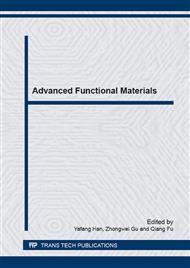p.483
p.489
p.496
p.503
p.509
p.515
p.523
p.529
p.534
Effects of the Coupling Agent on the Mechanical Properties of Long Glass Fiber Reinforced Polyphenylene Sulfide Composites
Abstract:
In this paper, we investigated the effects of a coupling agent (KH560) on the mechanical properties of long glass fiber (LGF) reinforced polyphenylene sulfide (PPS) composites. The LGF reinforced PPS composites were prepared utilizing our self-designed mold. It’s found that KH560 was beneficial for improving the mechanical properties of the composites. Meanwhile, the fiber lengths of glass fibers in the original injection molded sample and near the fracture surface were measured under the optical microscope. Comparing to the untreated sample, the sample with KH560 possessed higher proportion of fiber length on 0.75-1.25 mm. It suggested that KH560 could protect glass fibers from broken. Meanwhile, near the fracture surface, two composites possessed similar proportions of fiber length on 0-0.75 mm. That indicated KH560 improved the interfacial bonding between glass fiber and PPS. Scanning electron microscopy (SEM) images showed that more resin adsorbed on the fiber surface, which was consistent with the above phenomena.
Info:
Periodical:
Pages:
509-514
Citation:
Online since:
March 2015
Authors:
Keywords:
Price:
Сopyright:
© 2015 Trans Tech Publications Ltd. All Rights Reserved
Share:
Citation:


